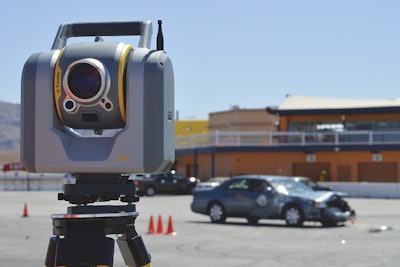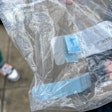 Photo: Trimble
Photo: Trimble
When all of those once very popular crime scene investigation TV shows debuted back around the year 2000, people were wowed by the high-tech gear. Nearly 20 years later that gear looks as high tech as steam engines. The tools now available to law enforcement forensic investigators can do amazing things like pull data off of mobile devices and even drones, close multiple cases through bullet and casing comparisons, and take 3D scans of entire crime scenes; saving investigators the tedious work of taking measurements.
 Cellebrite’s Pathfinder can automate the analysis of digital data using AI to identify patterns, reveal connections, and uncover leads.Photo: Cellebrite
Cellebrite’s Pathfinder can automate the analysis of digital data using AI to identify patterns, reveal connections, and uncover leads.Photo: Cellebrite
Ones and Zeroes
Cellebrite has for some time now been the best known producer of digital forensic investigation tools used in fighting both conventional and cyber crime. Company sources say that Cellebrite tools are used to help solve 5 million criminal cases per year, including homicides, crimes against children, human trafficking, drug trafficking, and organized crime operations.
Cellebrite recently announced that it was rebranding its digital intelligence tools. Mark Gambill, Cellebrite’s executive vice president and chief marketing officer, says the company worked closely with its law enforcement customers to understand their needs and narrowed it down to three areas.
“First, agencies need tools that help them access the ever-growing number of data types and sources, including mobile devices, computers, cloud-based applications, cameras, smart cars, drones, smart home appliances, and wearables, to name a few. Second, they are looking for ways to securely manage and control the collected digital data and evidence. Finally, with such vast amounts of data being stored on any given device today, agencies need help visually analyzing the digital evidence and creating actionable, credible intelligence,” he says.
The newest versions of Cellebrite’s digital intelligence solutions feature two major upgrades that optimize investigation workflows and help users develop data analysis for actionable evidence. “The UFED Cloud, for example, allows agencies to gain the ability to access cloud data from over 50 sources and instantly view digital activity across multiple devices and locations, including device backups,” Gambill explains. “Additionally, customers can automate the analysis of digital data using AI to identify patterns, reveal connections, and uncover leads with greater speed and accuracy with Cellebrite Pathfinder.”
Cellebrite’s digital intelligence solutions have been used effectively in a number of high-profile cases. They can be particularly valuable in child exploitation investigations. For example, the Glastonbury (CT) Police Department used Cellebrite solutions to investigate and prosecute a man for child
pornography.
After securing a search warrant, local investigators and federal agents went to the suspect’s home. There they found evidence on 50 devices, including images and videos.
The Glastonbury police contacted the National Center for Missing and Exploited Children (NCMEC) to help identify the victims. NCMEC partners with Cellebrite, so it requested the assistance of a Cellebrite technical team. Cellebrite’s experts used the company’s digital intelligence solutions to analyze 50 devices seized in the suspect’s home containing a total of 35TB of data.
With NCMEC and Cellebrite’s help, Glastonbury police were able to present prosecutors with enough evidence for an indictment and that led to a 12-year prison sentence for the offender.
 Ultra Forensic Technology’s IBIS technology powers the National Integrated Ballistic Information Network (NIBIN), which is administered by the ATF. IBIS lets analysts compare bullets and casings from multiple sources and get high-confidence matches.Photo: Ultra Forensic Technology
Ultra Forensic Technology’s IBIS technology powers the National Integrated Ballistic Information Network (NIBIN), which is administered by the ATF. IBIS lets analysts compare bullets and casings from multiple sources and get high-confidence matches.Photo: Ultra Forensic Technology
Bullets and Casings
Ultra Forensic Technology’s Integrated Ballistic Identification System (IBIS) powers the National Integrated Ballistic Information Network (NIBIN), which is administered by the Bureau of Alcohol, Tobacco, Firearms, and Explosives.
Using IBIS, analysts can compare bullets and cartridge cases from multiple sources and get high-confidence matches. “IBIS finds the needle in the haystack to advance criminal investigations and a law enforcement agency’s violent crime reduction strategy,” the company says.
IBIS includes image acquisition, correlation, visual comparison, and microscopic confirmation. It consists of four products to accomplish these tasks. BrassTrax and BulletTrax are image-acquisition stations that give examiners the ability to capture images of the surfaces of bullets and casings. The Correlation Server Engine is the brains behind the system. It uses algorithms to compare exhibits in a specific IBIS network and ranks matches according to similarity. The MatchPoint visualization station allows examiners to do visual comparisons and perform high-level analysis of the correlation results. Ultra also makes the VisionX, a comparison microscope used by examiners to visually confirm that two bullets were fired from the same gun.
Ultra’s IBIS system is the world’s most used ballistic analysis solution. It has helped solve crimes ranging from straight-up murders to illegal firearms possession.
IBIS became even more critical to investigations in 2016 when the ATF established the NIBIN National Correlation and Training Center. The Center is an invaluable tool for detectives nationwide. It can generate leads from ballistic evidence within 48 hours. Prior to the establishment of this resource, ballistic analysis to develop leads routinely took months to complete.
An example of how IBIS helps close cases—sometimes multiple seemingly unrelated cases—comes from Detroit. After a shooting at a gas station, casings recovered at the scene were entered into NIBIN by the investigators. Months later a limousine driver was murdered at another gas station. NIBIN linked the two crimes and that gave investigators the intelligence needed to identify the shooter and gather enough evidence that prosecutors could indict and convict him. He is serving a lifetime sentence.
 Trimble’s SX10 is a scanning total station that lets an accident reconstruction specialist or crime scene investigator collect all of their scans, photographs, and measurements on one device.(Photo: Trimble)
Trimble’s SX10 is a scanning total station that lets an accident reconstruction specialist or crime scene investigator collect all of their scans, photographs, and measurements on one device.(Photo: Trimble)
Crime Scene Scanning
In recent years, 3D scanners have become a fixture at crime scenes and accident scenes. The scanners are replacing a variety of manual measurement tools and analog systems, and they are giving crime scene investigators and accident reconstruction teams the ability to do their jobs faster and with more detail.
One of the leading producers of forensic scanners is the forensics division of Trimble, a public company that started as a GPS technology developer in the 1970s and branched into numerous industries, including public safety. Trimble makes two scanning systems for law enforcement, the SX10 and the X7.
Trimble’s SX10 is a scanning total station, a hybrid between a surveyor’s tool and a 3D scanner. The company says this lets a CSI or accident reconstruction specialist collect all of their scans, photographs, and digital measurements on one device. Trimble’s SX10 scanner can be controlled with its Capture software, which runs on Windows and Android.
The X7, Trimble’s other forensics scanner, is a 3D scanner designed to be particularly applicable to crime scene work. In March Chad McFadden, business area director for Trimble, told POLICE the X7 can create photorealistic 3D models. The data captured allows analysts to collect precise dimensions, evidence, and features recorded for later analysis. By capturing large amounts of data quickly, McFadden says investigators can create a complete 360-degree image of a scene in minutes.
“This easy-to-use scanner allows an officer to scan their entire scene and automatically create a fully registered project before they even get back to the office,” the company says. The X7 offers full in the field automatic registration, which is not available on any other scanner on the market, according to Trimble. “This allows an officer to scan a scene completely and check that they have all of the necessary information before then leave the scene.”
All of Trimble’s forensics products were “built from the ground up” with input from law enforcement users to create easy-to-use workflows, the company says, adding that it didn’t just rebrand the existing survey workflows for the police users. “At Trimble Forensics we understand that on scene, whether collision or crime, there are many pressures and stressors. One of these should not be the solutions that they are using. We have designed our solutions to be intuitive and directed so the officers can focus on the evidence.”















